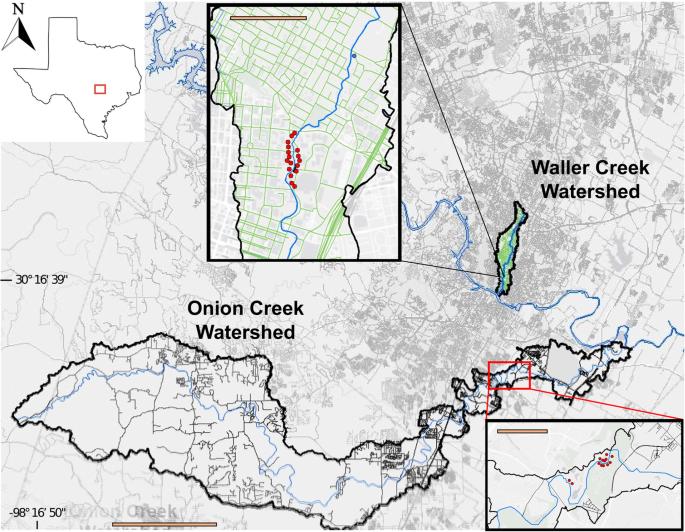Positive unintended consequences of urbanization for climate-resilience of stream ecosystems
IF 8.8
Q1 ENVIRONMENTAL STUDIES
引用次数: 0
Abstract
Developing sustainable urban systems is a fundamental societal challenge for the 21st century, and central Texas faces particularly synergistic challenges of a rapidly growing urban population and a projected increasingly drought-prone climate. To assess the history of urbanization impacts on watersheds here, we analyzed 51 cores from bald cypress trees in paired urban and rural watersheds in Austin, Texas. We find a significant contrast between rural and urbanized watersheds. In the rural watershed, tree-ring-width growth histories (“chronologies”) from 1844–2018 significantly and positively correlate (p < 0.01) with (1) one another, and (2) regional instrumental and proxy records of drought. In the urbanized watershed, by contrast, chronologies weakly correlate with one another, with instrumental records of drought, and with the rural chronologies and regional records. Relatively weak drought limitations to urban tree growth are consistent with the significant present-day transfer of municipal water from urban infrastructure by leakage and irrigation to the natural hydrologic system. We infer a significant, long-term contribution from infrastructure to baseflow in urbanized watersheds. In contrast to the common negative impacts of ‘urban stream syndrome’, such sustained baseflow in watersheds with impaired or failing infrastructure may be an unintended positive consequence for stream ecosystems, as a mitigation against projected extended 21st-century droughts. Additionally, riparian trees may serve as a proxy for past impacts of urbanization on natural streams, which may inform sustainable urban development.

城市化对溪流生态系统气候适应能力的积极意外后果
发展可持续的城市系统是 21 世纪的一项基本社会挑战,得克萨斯州中部尤其面临着城市人口快速增长和预计气候日益干旱的协同挑战。为了评估城市化对这里流域的历史影响,我们分析了德克萨斯州奥斯汀城市和农村成对流域的 51 棵秃柏树的树芯。我们发现,农村流域和城市化流域之间存在明显的反差。在农村流域,1844-2018 年的树环宽度生长历史("年表")与(1)相互之间,以及(2)区域干旱的工具和替代记录之间存在显著的正相关性(p < 0.01)。相比之下,在城市化流域,年代学相互之间、与干旱的仪器记录以及与农村年代学和区域记录之间的相关性较弱。干旱对城市树木生长的限制相对较弱,这与当今城市基础设施通过渗漏和灌溉向自然水文系统输送大量市政用水是一致的。我们推断,基础设施对城市化流域的基流具有重要的长期贡献。与常见的 "城市溪流综合症 "的负面影响不同,在基础设施受损或失效的流域中,这种持续的基流可能会对溪流生态系统产生意想不到的积极影响,从而缓解 21 世纪预计会出现的长期干旱。此外,河岸树木可以作为过去城市化对自然河流影响的替代物,为城市可持续发展提供参考。
本文章由计算机程序翻译,如有差异,请以英文原文为准。
求助全文
约1分钟内获得全文
求助全文

 求助内容:
求助内容: 应助结果提醒方式:
应助结果提醒方式:


